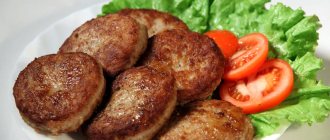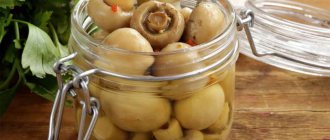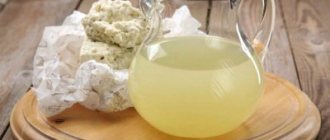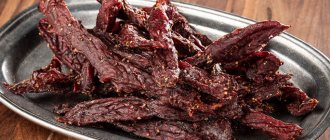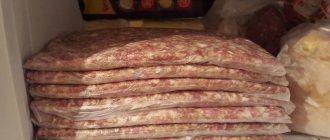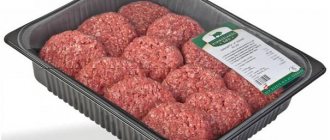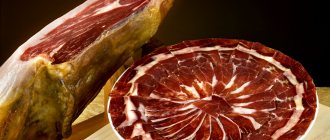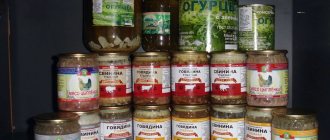Most people consume meat in their daily diet. And they buy it several kilograms at a time, so as not to go shopping every day. Beef does not appear as often in our diet as, for example, chicken. But they store it at home much more often. Today we will talk about how to properly store beef in the refrigerator, freezer, raw and boiled. And also how to choose it correctly.
Storing meat in the freezer
It is believed that the optimal temperature of the freezer is -18 °C.
The main condition for storing meat in the freezer is the absence of air in the packaging. Try to get all the air out of the meat bag and seal it tightly. If you have a special vacuum sealer, great, use it. It also doesn't hurt to wrap the bag of meat in foil.
To prevent large pieces from freezing, wrap each piece in cling film.
Be sure to sign all packages and containers. This way you will always know how long the meat has been in the freezer.
A whole chicken, duck, goose or turkey can be stored in the freezer for a very long time - up to 12 months. It is recommended to store individual parts of the bird for no more than 9 months.
Large cuts of beef, veal, pork and lamb can also be stored in the freezer for six months to a year. Small pieces of red meat will last less - 4-6 months.
Game (but not wild fowl) can be stored for 8–12 months.
Frozen minced meat will last no more than 3-4 months.
Cooked frozen meat retains its properties for 2–6 months.
Requirements according to GOST and SanPin
The quality of meat products in stores and enterprises is controlled by authorized bodies (Rospotrebnadzor). Periodically, they conduct inspections to determine whether meat products meet all the requirements of sanitary rules and regulations.
These requirements are prescribed by current legislative acts, which also regulate them.
A number of GOST standards have been approved for each type of meat and products made from it. Storage rules, as well as conditions for the safety of the product and its shelf life are established in accordance with GOST 28589-2014, GOST 31797-2012, GOST 31778-2012, as well as GOST 32752-2014 and others.
The safety of meat and meat products must be ensured by specialized equipment that maintains the required temperature conditions. To determine the quality of meat, two methods are used: organoleptic evaluation and testing of samples of meat and meat products directly taken from the point of sale.
Organoleptic analysis of meat is carried out before it goes on sale. Samples are examined in laboratories, after which the test is carried out by a tasting commission, which uses classification according to points prescribed in the GOST 9959-12 appendix. The test results are recorded on a tasting sheet, and a protocol is drawn up at the end of the test. Veterinary and sanitary examination is identical to organoleptic assessment, only samples are taken directly at retail outlets. They are subjected to laboratory analysis and a hygienic assessment. Based on the results of the examination, an expert opinion is drawn up.
The appearance of meat and meat products, their structure, and smell must meet the requirements for their quality.
The cut meat should not differ in color from its bulk.
The surface of the product should be free of suspicious formations, and the smell should be natural.
Quality meat must be classified according to:
- To its mass.
- The age of the animal.
- Thermal condition (chilled fresh, fresh frozen, cooked stew, boiled meat).
The quality of chilled fresh meat is characterized by a pale red, slightly dried layer on the surface of the meat, the elasticity of the fiber structure, when cut, the color of the meat should match the color characteristic of this type of meat, the juice should be transparent.
Frozen meat should be red, pinkish with a slightly gray tint at the cut site, and when re-frozen, the meat will have a dark red tint.
Stewed and boiled meat should not be tough, but have a juicy soft structure. Meat dishes should not have any foreign taste or smell.
Responsibility for a low-quality product lies with the seller and manufacturer. Products that have not passed the test and whose quality does not meet the requirements are confiscated and destroyed.
People's secrets of safety
If it is not possible to store the cooked product in the freezer, and you cannot eat everything, you can use traditional methods:
- In hot weather, you can preserve meat for several days using nettles. To do this, you need to wrap the piece with plant leaves.
- Brush the piece with lemon juice and place in a glass or ceramic container. Be sure to cover with a lid. This method makes it possible to preserve the freshness and taste of the product for up to two days, and in winter – up to three.
Storing meat without a refrigerator or freezer
If you're going on a long hike or just want to stock up on meat for future use, and your freezer isn't big enough to go around, consider alternative ways to store meat.
Pickling
Salt destroys microbes, dries the meat and allows it not to spoil for a long time. There are two main methods of salting. You can rub the meat with salt, let the released liquid drain and get a dry product. To make the meat more tasty, you can add herbs and spices to the salt or pre-marinate it with vinegar. Or you can soak the meat in a saline solution, adding honey or brown sugar for taste.
There are many recipes, but Lifehacker found the simplest one.
How to cook corned beef
Place the pieces of meat in a bag or jar with a tight-fitting lid and sprinkle them with salt. Make sure that the meat is covered with salt on all sides.
Close the jar or bag tightly and put it in a cool place (2–4 °C, but never below zero).
The aging period for meat is calculated as follows: 3 days for each centimeter of meat. For example, a piece 10 cm thick will be salted for a month. Corned beef in a jar with a volume of no more than 1 liter is prepared for at least 3 weeks.
Rinse meat with water before eating. Corned beef can be stored without refrigeration for 3-4 months if kept in a container that does not allow air to pass through.
Drying
Cut the meat into narrow strips approximately 1 cm thick. Boil the meat for 3-5 minutes. Then take it out of the water and let it dry completely.
Salt the meat strips and season with spices to taste.
Place a sheet of parchment on a baking sheet, place the meat in a single layer and place in the oven. Select the minimum temperature and turn on the ventilation mode or open the door slightly. After 8–12 hours the meat is ready.
Dried meat can be stored for up to 2 months without refrigeration in a tightly closed container.
Canning
Canned meat can be stored for years. The only thing you need to take into account: for canning meat, in addition to jars with lids, you need a special device called an autoclave.
FoodCraftLab/flickr.com
This is a rather cumbersome thing that not everyone has on their household. However, it is precisely this that guarantees the safety of canned meat. Grandma’s old method of canning with steamed sterilization of jars, alas, is not safe enough for meat.
You can preserve both boiled and raw meat.
Canning boiled meat
Boil the meat with salt and spices until half cooked. Then transfer the pieces into hot sterile jars and fill with hot broth almost to the top.
Wipe the jars, close them tightly with lids and place in the autoclave. Next, follow the instructions for using the autoclave.
How to choose
High-quality beef should have a uniform color without dark spots (fat inclusions are acceptable). And its color should correspond to its age:
- red for an adult animal;
- pink - for calf
Fresh beef should have a pleasant aroma, without foreign odors. And after pressing, quickly restore the original shape.
The layers of fat in a fresh product should be evenly spaced and have a uniform consistency. They shouldn't have any smell. And the color of the fat layers should only be white. A yellow layer is an indication that the meat may be tough.
When beef dries out, a thin crust may form on it. This is a natural process and does not affect the quality of the product in any way. And the presence of a large amount of moisture on the surface may be an indicator of improper storage.
It is better not to buy beef that is in a puddle of red color.
When purchasing frozen beef, pay attention to ice crystals. They should be colorless. Pink ice indicates that the meat has already been defrosted and frozen again (maybe even more than once).
Dark spots on the surface may form from long-term storage. It's better not to buy such a product.
How to pickle properly for long-term storage
Beef and pork can be stored in vinegar marinade:
- Pour 8 tablespoons of water into a glass;
- dilute 4 tablespoons of vinegar 9% in water;
- pour a teaspoon of sugar into the bowl with meat;
- pour in vinegar solution.
Pickled meat is stored under cling film for up to 7 days.
Benefits of chilled meat
Chilled beef, pork or chicken is always ready for immediate cooking. Frozen meat must first thaw, which takes a lot of time. At the same time, using a microwave significantly speeds up the process, but it is not always possible to achieve a good result. In some cases, especially when the piece is thick enough, it happens that the meat is still frozen inside, but is already fried on top. Therefore, if you plan to prepare a delicious dish, you need to take the product out of the freezer in advance.
Another advantage of chilled meat compared to frozen meat is that it retains all the beneficial substances. It is also considered the most delicious.
What determines the suitability of a product by category: tables
Attention! Quality production and safe use are achieved only through careful adherence to all recommended principles of product storage.
The meat industry operates in accordance with established regulatory documents:
- Technical Regulations of the Customs Union 021/2011 “On the safety of food products” dated December 9, 2011 No. 880.
- Technical Regulations of the Customs Union “On the safety of meat and meat products” 034/2013 dated 10/09/2013 No. 68.
And how long frozen meat or semi-finished meat products will be stored in the refrigerator after defrosting, in vacuum or regular packaging, will be clearly shown in the tables.
Doubles
Meat is considered fresh for 1.5 hours from the moment of slaughter. The temperature of the depth of the muscle layer of this type of meat product ranges from +25⁰С and differs slightly in different parts of the carcass.
| Type of meat products | Shelf life (in days) | Storage conditions |
| pork | up to 12 | at temperatures from 0⁰С to -2⁰С, air humidity 85-90%, with air circulation about 0.1 m/s |
| beef | up to 16 | |
| mutton | up to 12 | |
| bird/game | up to 5 |
Chilled
Important! Chilled meat is obtained after cutting the meat carcass and bringing it to the temperature of the muscle layer from 0⁰С to +4⁰С in refrigeration units.
The surface of the chilled meat has a dried crust, and the muscle layer is elastic.
| Type of meat products | Shelf life (in days) | Storage conditions |
| pork | up to 20 | at temperatures from -3⁰С to -2⁰С, air humidity 85-95%, with air circulation about 0.1 m/s |
| beef | up to 20 | |
| mutton | up to 12 | |
| bird/game | up to 5 |
Frozen
Frozen meat is a product that has gone through the freezing stage, as a result of which the temperature of the muscle layer does not exceed -8⁰C. This meat has a longer shelf life, since in frozen products the development of pathogenic microflora is maximally inhibited.
| Type of meat products | Shelf life (in months) | Storage conditions |
| pork | until 3 | at a temperature of -12⁰С, air humidity 95-98%, with air circulation of about 0.1 m/s |
| beef | up to 8 | |
| mutton | until 6 | |
| bird/game | up to 2 |
Pickled
Attention! The shelf life of marinated meat is greatly influenced by the ingredients used during the marinating process.
For example, the use of onions, spices and garlic extends the shelf life of the product by 2-3 days due to the ability of the components to kill microorganisms.
| Type of meat products | Shelf life (in days) | Storage conditions |
| pork | until 3 | at temperatures from 0⁰С to -4⁰С, air humidity 80-95%, with air circulation of about 0.1 m/s |
| beef | up to 2 | |
| mutton | up to 2 | |
| bird/game | up to 4 |
The use of vacuum packaging increases the shelf life of meat products by 2-3 times.
Types of beef
- Beef is usually called the meat of cattle (bull, cow, ox). It has a fibrous structure and red color.
- Veal is the meat of a young animal (calf). It is pink and very useful (for children and the elderly). In terms of nutritional value, the best veal is tenderloin.
- The tender meat of a young calf is most prized.
- The best taste is in meat from animals aged 20 months. It is colored bright red, and its layers of fat are white with a creamy tint.
- An old animal can be recognized by the dark red color of the beef and yellow fat.
The freshest meat is fresh. It has the highest nutritional value, since this type of meat contains the most vitamins and beneficial microelements. This product is sold chilled at 0°C - +4°C, and if you store beef in the freezer, this should be done at -40°C -10°C.
